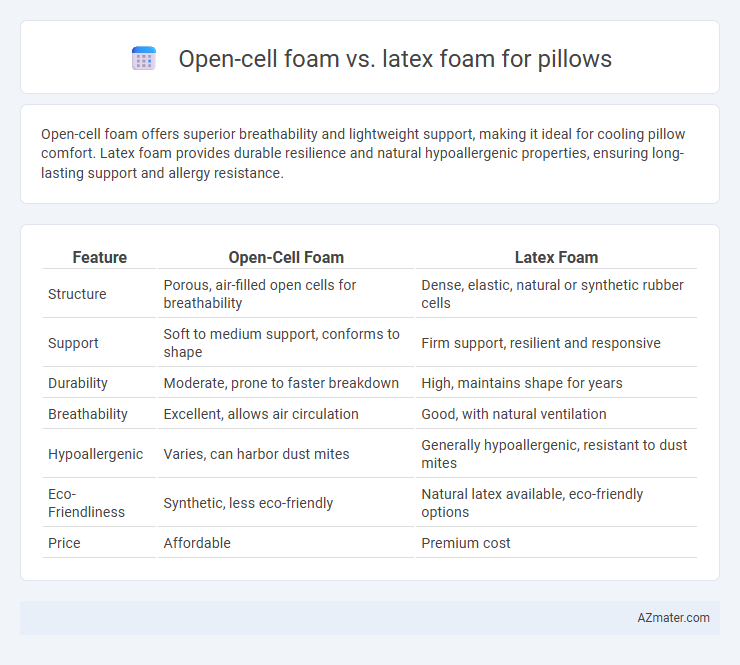Open-cell foam offers superior breathability and lightweight support, making it ideal for cooling pillow comfort. Latex foam provides durable resilience and natural hypoallergenic properties, ensuring long-lasting support and allergy resistance.
Table of Comparison
| Feature | Open-Cell Foam | Latex Foam |
|---|---|---|
| Structure | Porous, air-filled open cells for breathability | Dense, elastic, natural or synthetic rubber cells |
| Support | Soft to medium support, conforms to shape | Firm support, resilient and responsive |
| Durability | Moderate, prone to faster breakdown | High, maintains shape for years |
| Breathability | Excellent, allows air circulation | Good, with natural ventilation |
| Hypoallergenic | Varies, can harbor dust mites | Generally hypoallergenic, resistant to dust mites |
| Eco-Friendliness | Synthetic, less eco-friendly | Natural latex available, eco-friendly options |
| Price | Affordable | Premium cost |
Introduction to Foam Types for Pillows
Open-cell foam offers a breathable structure with interconnected pores that enhance airflow, making it ideal for pillows requiring temperature regulation and softness. Latex foam provides durable support with natural elasticity and hypoallergenic properties, suited for sleepers seeking resilience and pressure relief. Both foam types vary in density and firmness, influencing comfort and spinal alignment preferences in pillows.
What is Open-Cell Foam?
Open-cell foam is a type of polyurethane foam characterized by its porous, breathable structure that allows air to flow freely, making it ideal for pillows requiring cooling and ventilation. This foam provides a soft, cushioned feel that contours to the head and neck, offering pressure relief and comfort. Compared to latex foam, open-cell foam typically has greater breathability but may be less durable and resilient over time.
Understanding Latex Foam
Latex foam, derived from natural rubber or synthetic sources, offers exceptional durability, breathability, and resilience, making it a superior choice for pillow comfort and support. Its open-cell structure allows for enhanced airflow, reducing heat retention compared to many traditional foams. Latex foam pillows provide hypoallergenic and antimicrobial properties, promoting a healthier sleep environment while maintaining consistent pressure relief and preventing premature sagging.
Breathability and Temperature Regulation
Open-cell foam offers superior breathability due to its porous structure, allowing air to circulate freely and dissipate heat, which helps maintain a cooler sleeping surface. Latex foam, while denser, incorporates natural ventilation through pinholes and inherent elasticity that enhances airflow and reduces heat retention. Both materials provide effective temperature regulation, but open-cell foam is typically preferred for those prioritizing maximum breathability.
Support and Comfort Comparison
Open-cell foam offers superior airflow and breathability, providing moderate support with a soft, contouring feel that adapts to head and neck shapes, making it ideal for those seeking pressure relief. Latex foam delivers firmer, more consistent support due to its high resilience and natural elasticity, maintaining optimal spinal alignment while offering a responsive and buoyant comfort. Both materials excel in durability, but latex foam generally outperforms open-cell foam in long-term support retention and hypoallergenic properties.
Durability and Longevity
Open-cell foam pillows offer moderate durability with a tendency to compress and lose support over time due to their porous structure, typically lasting around 2-3 years. Latex foam pillows, especially those made from natural latex, provide superior longevity and resilience, maintaining shape and firmness for 5-7 years or more. The inherent elasticity and resistance to wear distinguish latex foam as a more durable option for long-term pillow use.
Allergy Considerations
Open-cell foam pillows offer enhanced breathability and hypoallergenic properties by preventing dust mite accumulation and reducing moisture retention, which helps minimize allergy symptoms. Latex foam pillows naturally resist mold, mildew, and dust mites due to their dense cellular structure and antimicrobial agents, making them ideal for allergy sufferers. Both materials provide effective support with latex foam typically favored for its durability and resistance to allergens without the use of chemical treatments.
Eco-Friendliness and Sustainability
Open-cell foam pillows offer breathability and comfort but often rely on petrochemical-based materials, which can limit their eco-friendliness and biodegradability. Latex foam, especially natural latex derived from rubber tree sap, stands out for its sustainable production, biodegradability, and resistance to dust mites and mold, making it a more environmentally responsible choice. Certifications like GOLS (Global Organic Latex Standard) further validate the eco-friendly attributes of natural latex foam pillows.
Price Differences Between Foams
Open-cell foam pillows are generally more affordable due to their simpler manufacturing process and lower material costs compared to latex foam, which is derived from natural or synthetic rubber and involves more complex production. Latex foam pillows tend to have higher price points reflecting their durability, hypoallergenic properties, and natural resistance to dust mites and mold. Consumers often choose open-cell foam for budget-friendly options, while latex foam appeals to those seeking premium comfort and longevity despite the increased investment.
Choosing the Right Foam Pillow for You
Open-cell foam offers excellent breathability and cooling properties, making it ideal for hot sleepers who need temperature regulation. Latex foam provides natural resilience and pressure relief, suited for those seeking durable support and hypoallergenic materials. When choosing the right foam pillow, consider your sleeping position, temperature preferences, and sensitivity to allergens to select the best option for personalized comfort.

Infographic: Open-cell foam vs Latex foam for Pillow
 azmater.com
azmater.com